Spectral Line Reflectance and Fluorescence Imaging Device for Skin Diagnostics
Abstract
Featured Application
Abstract
1. Introduction
2. Method of Skin Chromophore Mapping
3. Design of the Prototype Device
4. The Device Test Results
5. Discussion
6. Patents
Author Contributions
Funding
Acknowledgments
Conflicts of Interest
References
- Shah, M.; Heath, R.; Chadwick, S. Abnormal pigmentation within cutaneous scars: A complication of wound healing. Indian J. Plast. Surg. 2012, 45, 403–411. [Google Scholar]
- Ngan, V.; Writer, S. Spectrophotometric Analysis of Skin Lesions | DermNet NZ. Available online: https://dermnetnz.org/topics/spectrophotometric-analysis-of-skin-lesions (accessed on 18 October 2020).
- Sterenborg, H.J.C.M.; Motamedi, M.; Wagner, R.F.; Duvic, M.; Thomsen, S.; Jacques, S.L. In vivo fluorescence spectroscopy and imaging of human skin tumours. Lasers Med. Sci. 1994, 9, 191–201. [Google Scholar] [CrossRef]
- Lihachev, A.; Derjabo, A.; Ferulova, I.; Lange, M.; Lihacova, I.; Spigulis, J. Autofluorescence imaging of basal cell carcinoma by smartphone RGB camera. J. Biomed. Opt. 2015, 20. [Google Scholar] [CrossRef] [PubMed]
- Bliznuks, D.; Derjabo, A.; Lihacova, I.; Bolochko, K.; Plorina, E.V.; Lange, M.; Lihachev, A. A method for skin malformation classification by combining multispectral and skin autofluorescence imaging. In Proceedings of the Biophotonics: Photonic Solutions for Better Health Care VI, Strasbourg, France, 23–26 April 2018; Volume 10685, p. 113. [Google Scholar]
- Anderson, R.R.; Parrish, J.A. The optics of human skin. J. Invest. Dermatol. 1981, 77, 13–19. [Google Scholar] [CrossRef] [PubMed]
- Välisuo, P.; Kaartinen, I.; Tuchin, V.; Alander, J. New closed-form approximation for skin chromophore mapping. J. Biomed. Opt. 2011, 16. [Google Scholar] [CrossRef] [PubMed]
- Ruvolo, E.C., Jr.; Bargo, P.R.; Dietz, T.; Scamuffa, R.; Shoemaker, K.; DiBernardo, B.; Kollias, N. Use of spectral imaging for documentation of skin parameters in face lift procedure. In Proceedings of the Photonic Therapeutics and Diagnostics VI, San Francisco, CA, USA, 23–25 January 2010; Volume 7548. [Google Scholar]
- Stratis, D.N.; Eland, K.L.; Carter, J.C.; Tomlinson, S.J.; Angel, S.M. Comparison of acousto-optic and liquid crystal tunable filters for laser-induced breakdown spectroscopy. Appl. Spectrosc. 2001, 55. [Google Scholar] [CrossRef]
- Randeberg, L.L.; Larsen, E.L.P.; Svaasand, L.O. Characterization of vascular structures and skin bruises using hyperspectral imaging, image analysis and diffusion theory. J. Biophotonics 2010, 3, 53–65. [Google Scholar] [CrossRef] [PubMed]
- Yudovsky, D.; Nouvong, A.; Schomacker, K.; Pilon, L. Assessing diabetic foot ulcer development risk with hyperspectral tissue oximetry. J. Biomed. Opt. 2011, 16. [Google Scholar] [CrossRef] [PubMed]
- Vasefi, F.; MacKinnon, N.; Saager, R.; Kelly, K.M.; Maly, T.; Booth, N.; Durkin, A.J.; Farkas, D.L. Separating melanin from hemodynamics in nevi using multimode hyperspectral dermoscopy and spatial frequency domain spectroscopy. J. Biomed. Opt. 2016, 21. [Google Scholar] [CrossRef] [PubMed]
- Kuzmina, I.; Diebele, I.; Spigulis, J.; Valeine, L.; Berzina, A.; Abelite, A. Contact and contactless diffuse reflectance spectroscopy: Potential for recovery monitoring of vascular lesions after intense pulsed light treatment. J. Biomed. Opt. 2011, 16. [Google Scholar] [CrossRef] [PubMed]
- Morimoto, C.; Chellappa, R. Evaluation of image stabilization algorithms. In Proceedings of the International Conference on Acoustics, Speech and Signal Processing, Seattle, WA, USA, 12–15 May 1998; Volume 5, pp. 2789–2792. [Google Scholar]
- Jakovels, D.; Rubins, U.; Spigulis, J. RGB imaging system for mapping and monitoring of hemoglobin distribution in skin. In Proceedings of the Imaging Spectrometry XVI, San Diego, CA, USA, 22–23 August 2011; Volume 8158. [Google Scholar]
- Kapsokalyvas, D.; Bruscino, N.; Alfieri, D.; de Giorgi, V.; Cannarozzo, G.; Cicchi, R.; Massi, D.; Pimpinelli, N.; Pavone, F.S. Spectral morphological analysis of skin lesions with a polarization multispectral dermoscope. Opt. Express 2013, 21. [Google Scholar] [CrossRef] [PubMed]
- Spigulis, J.; Oshina, I.; Potapovs, P.; Lauberts, K. Snapshot multi-spectral-line imaging for applications in dermatology and forensics. In Proceedings of the Imaging, Manipulation, and Analysis of Biomolecules, Cells, and Tissues XVII, San Francisco, CA, USA, 2–7 February 2019; Volume 10881. [Google Scholar]
- Spigulis, J.; Oshina, I.; Matulenko, M. Laser illumination designs for snapshot multi-spectral-line imaging. In Proceedings of the 2019 Conference on Lasers and Electro-Optics Europe and European Quantum Electronics Conference, CLEO, Munich, Germany, 23–27 June 2019. [Google Scholar]
- Spigulis, J.; Elste, L. Method and Device for Imaging of Spectral Reflectance at Several Wavelength Bands. WO 2013135311 A1, 16 July 2012. [Google Scholar]
- Spigulis, J.; Elste, L. Single snapshot RGB multispectral imaging at fixed wavelengths: Proof of concept. In Proceedings of the Multimodal Biomedical Imaging IX, San Francisco, CA, USA, 1–6 February 2014; Volume 8937. [Google Scholar]
- Spigulis, J. Multispectral, Fluorescent and Photoplethysmographic Imaging for Remote Skin Assessment. Sensors 2017, 17, 1165. [Google Scholar] [CrossRef] [PubMed]
- Oshina, I.; Potapovs, P.; Spigulis, J. Spectral imaging system for money counterfeit detection. In Proceedings of the Optics InfoBase Conference Papers, OSA Technical Digest, Munich, Germany, 24–27 June 2019, ITu3B.3.
- Spigulis, J.; Oshina, I. Snapshot RGB mapping of skin melanin and hemoglobin. J. Biomed. Opt. 2015, 20. [Google Scholar] [CrossRef] [PubMed]
- Spigulis, J.; Oshina, I.; Berzina, A.; Bykov, A. Smartphone snapshot mapping of skin chromophores under triple-wavelength laser illumination. J. Biomed. Opt. 2017, 22. [Google Scholar] [CrossRef] [PubMed]
- Spigulis, J.; Rupenheits, Z.; Matulenko, M.; Oshina, I.; Rubins, U. A snapshot multi-wavelengths imaging device for in-vivo skin diagnostics. In Proceedings of the Multimodal Biomedical Imaging XV, San Francisco, CA, USA, 6–11 March 2020. [Google Scholar]
- Prahl, S. Tabulated Molar Extinction Coefficient for Hemoglobin in Water. Available online: https://omlc.org/spectra/hemoglobin/summary.html (accessed on 18 October 2020).
- Sarna, T.; Swartz, H.M. The Physical Properties of Melanin. Available online: https://omlc.org/spectra/melanin/eumelanin.html (accessed on 18 October 2020).
- Spigulis, J.; Osina, I.; Rupenheits, Z.; Matulenko, M. Device for Uniform Surface Illumination Simultaneously by Several Spectral Lines. Patent LV 15491 B, 20 September 2020. [Google Scholar]
- Lihachev, A.; Lihacova, I.; Plorina, E.V.; Lange, M.; Derjabo, A.; Spigulis, J. Differentiation of seborrheic keratosis from basal cell carcinoma, nevi and melanoma by RGB autofluorescence imaging. Biomed. Opt. Express 2018, 9, 1852–1858. [Google Scholar] [CrossRef] [PubMed]
- Spigulis, J. Biophotonic technologies for noninvasive assessment of skin condition and blood microcirculation. Latv. J. Phys. Tech. Sci. 2012, 49, 63–80. [Google Scholar]
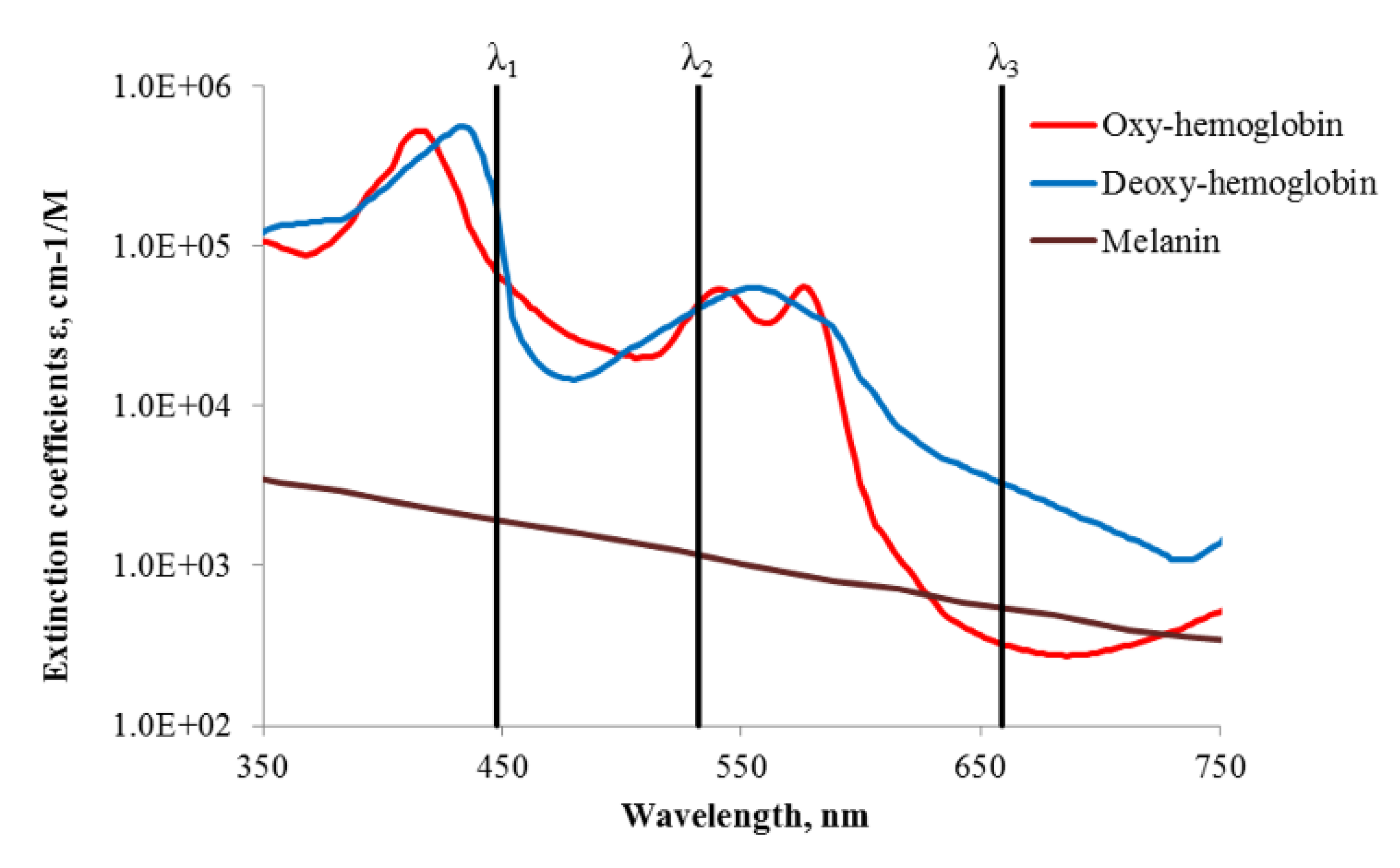
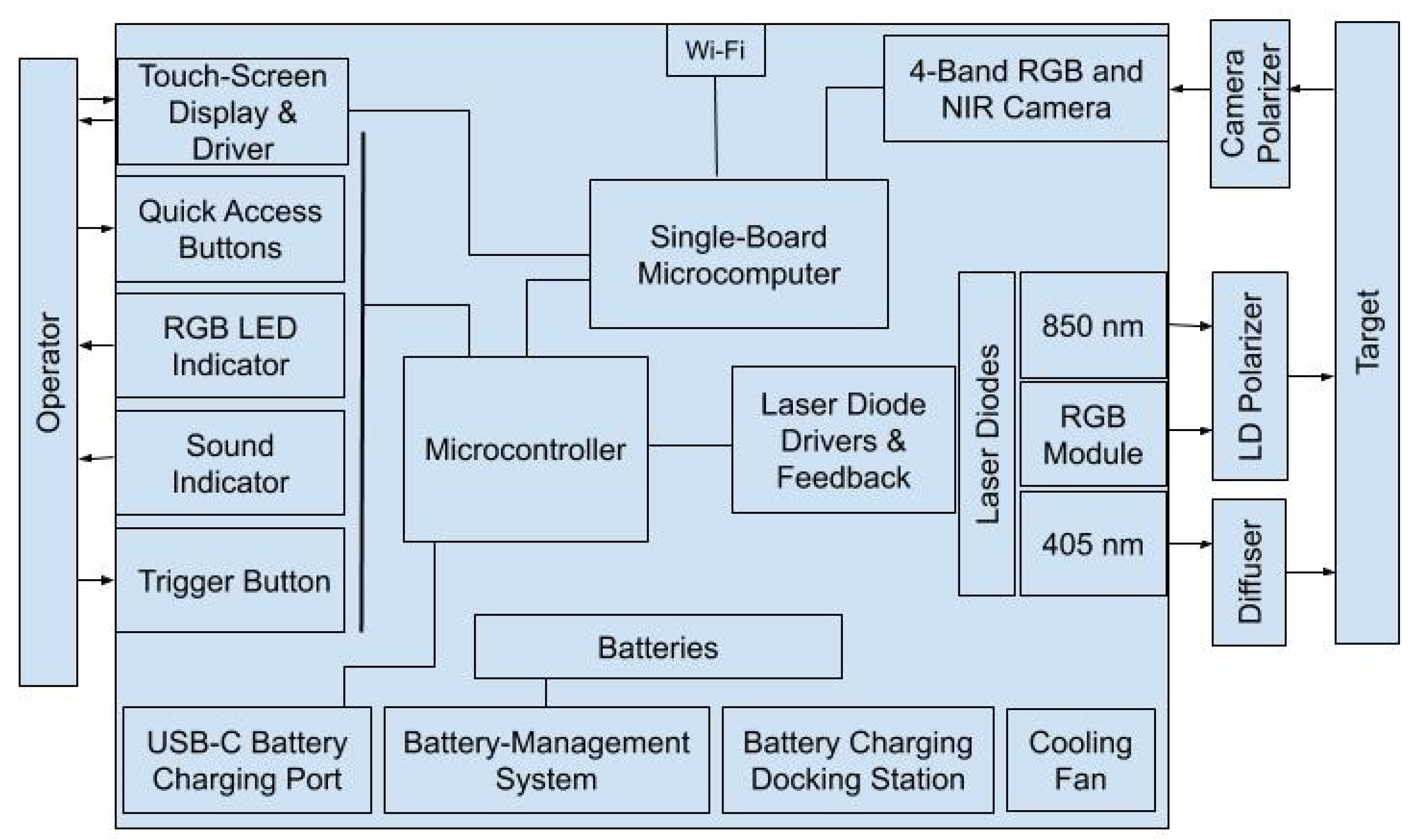
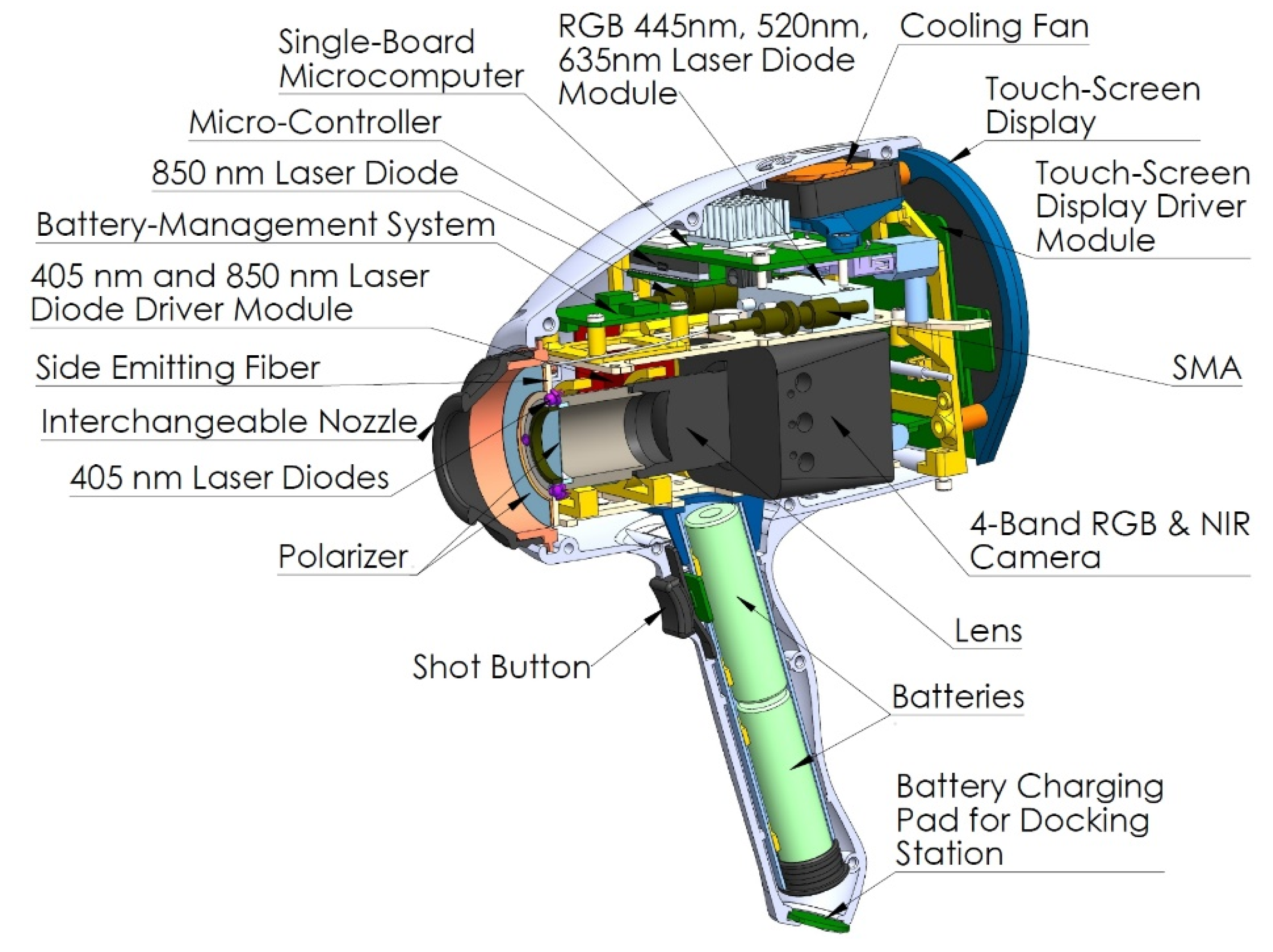
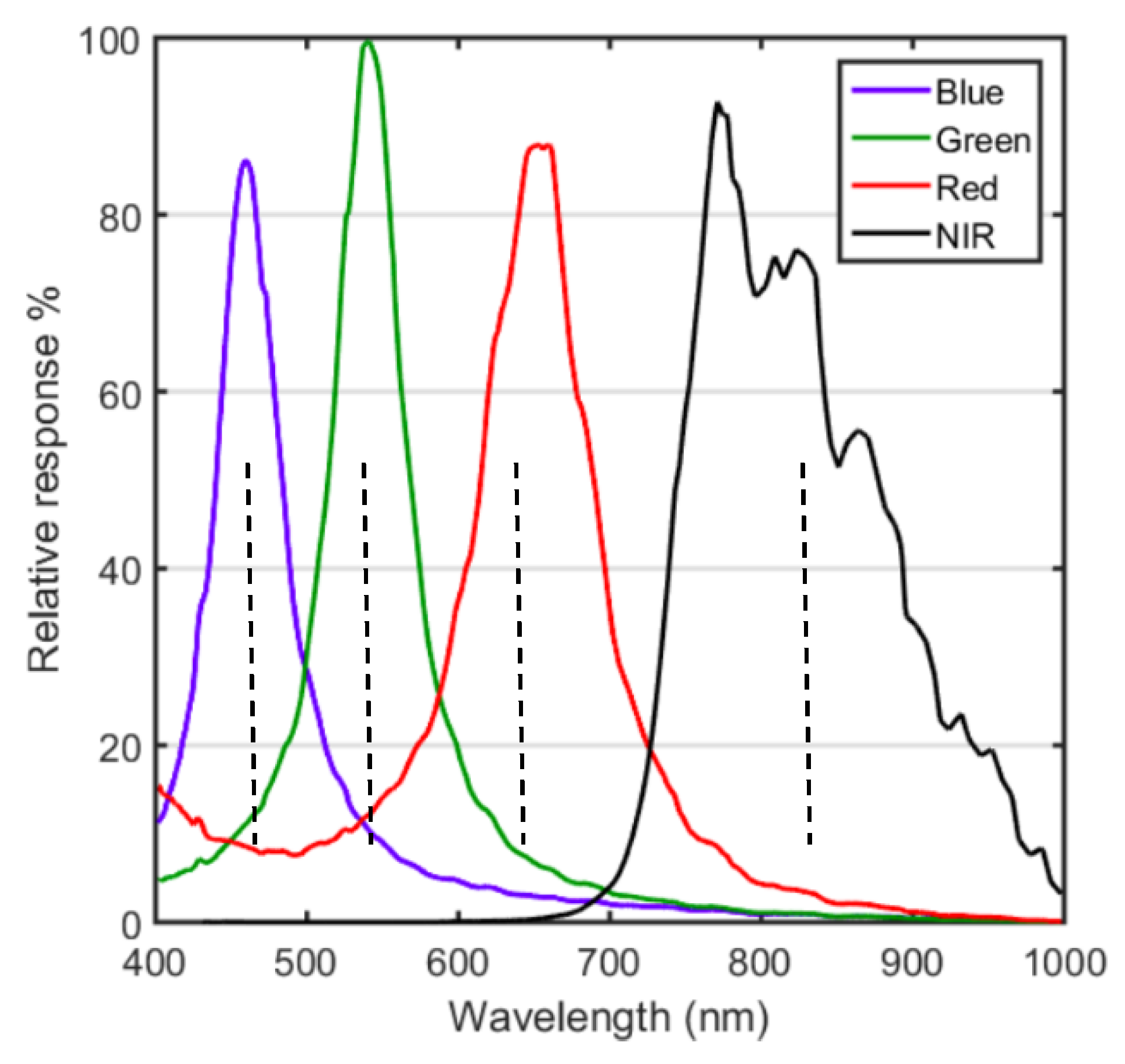
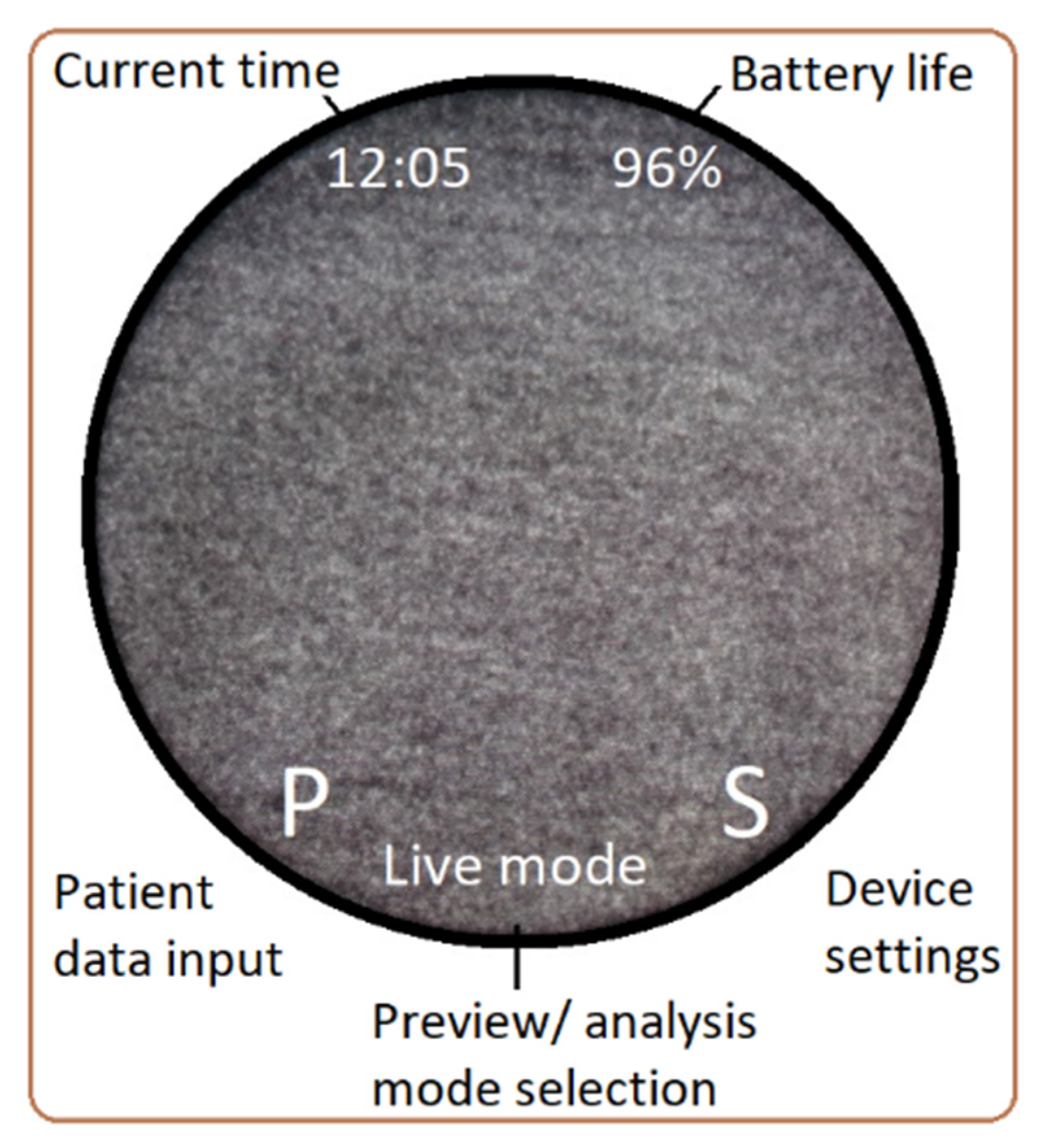
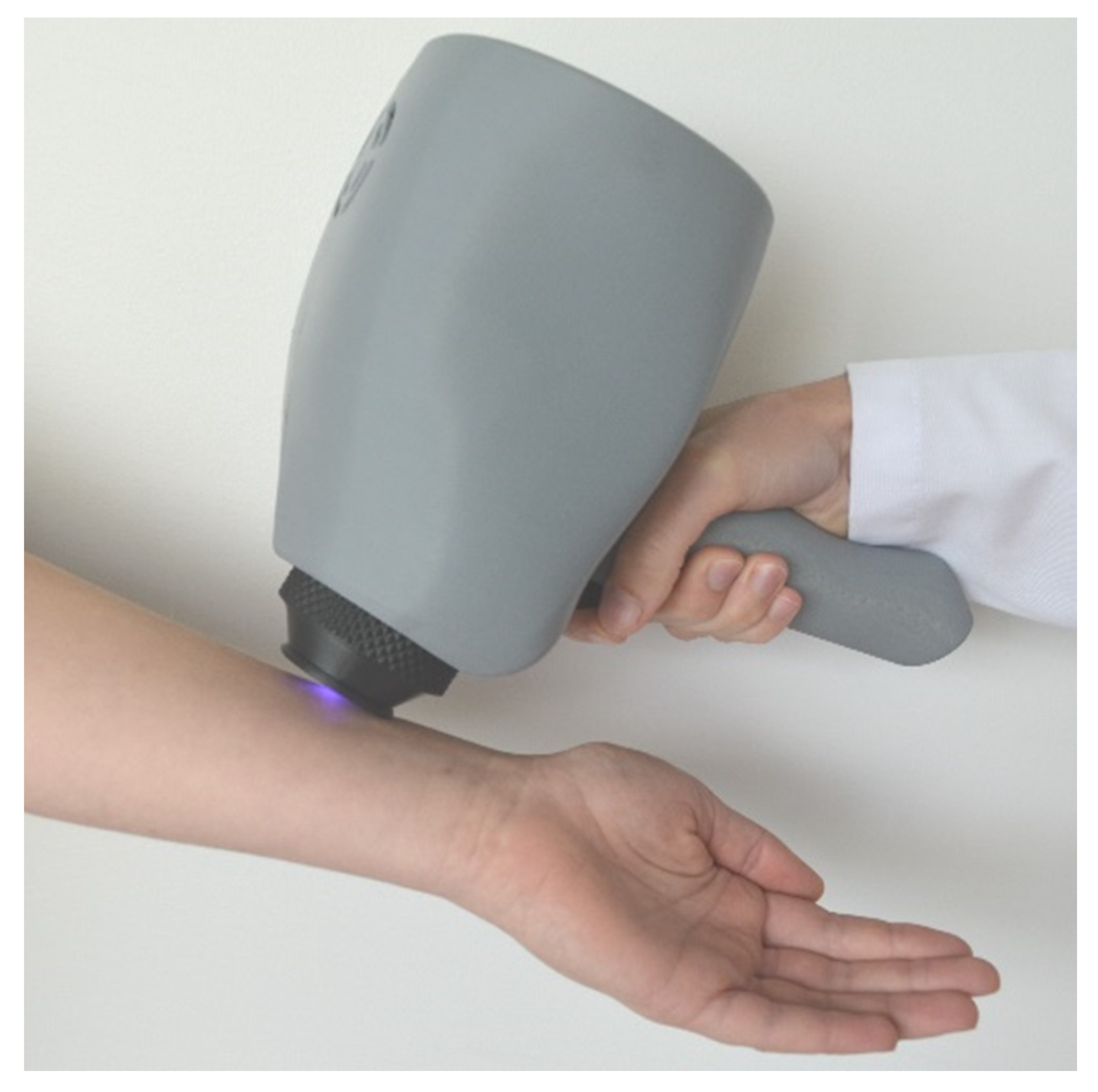
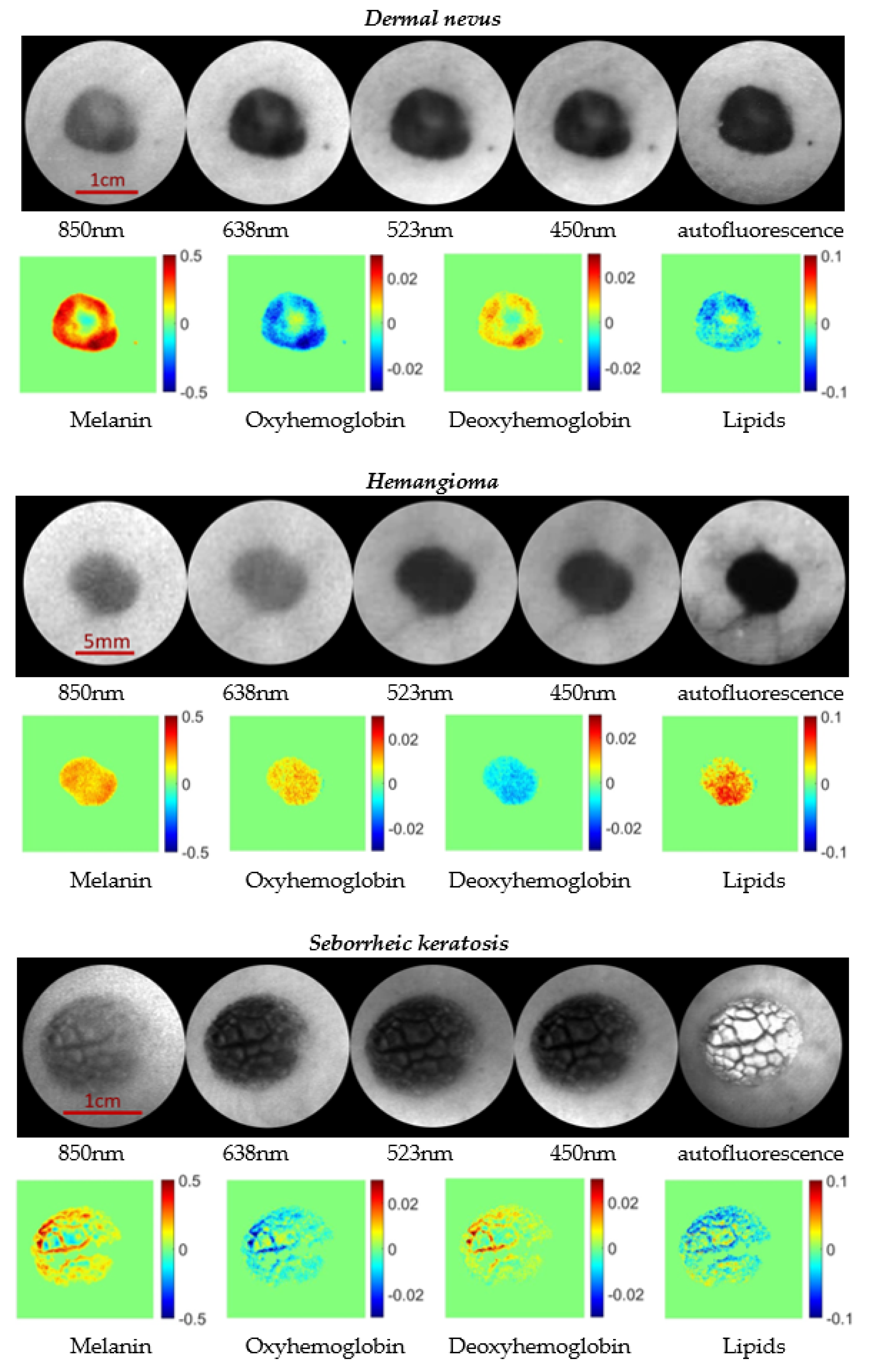
Publisher’s Note: MDPI stays neutral with regard to jurisdictional claims in published maps and institutional affiliations. |
© 2020 by the authors. Licensee MDPI, Basel, Switzerland. This article is an open access article distributed under the terms and conditions of the Creative Commons Attribution (CC BY) license (http://creativecommons.org/licenses/by/4.0/).
Share and Cite
Spigulis, J.; Rupenheits, Z.; Rubins, U.; Mileiko, M.; Oshina, I. Spectral Line Reflectance and Fluorescence Imaging Device for Skin Diagnostics. Appl. Sci. 2020, 10, 7472. https://doi.org/10.3390/app10217472
Spigulis J, Rupenheits Z, Rubins U, Mileiko M, Oshina I. Spectral Line Reflectance and Fluorescence Imaging Device for Skin Diagnostics. Applied Sciences. 2020; 10(21):7472. https://doi.org/10.3390/app10217472
Chicago/Turabian StyleSpigulis, Janis, Zigmars Rupenheits, Uldis Rubins, Madars Mileiko, and Ilze Oshina. 2020. "Spectral Line Reflectance and Fluorescence Imaging Device for Skin Diagnostics" Applied Sciences 10, no. 21: 7472. https://doi.org/10.3390/app10217472
APA StyleSpigulis, J., Rupenheits, Z., Rubins, U., Mileiko, M., & Oshina, I. (2020). Spectral Line Reflectance and Fluorescence Imaging Device for Skin Diagnostics. Applied Sciences, 10(21), 7472. https://doi.org/10.3390/app10217472




